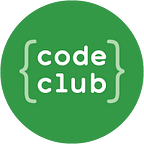Learning Paths explained — a journey from learner to designer
“How do I know what Code Club project I should pick for my class?” With over 170 self-guided projects for young people to learn how to code using tools like Scratch, Python, and more — it’s fair question!
There are many ways to answer this question. You can choose projects based on topic, theme, style of project eg game or animation, or you can use the curriculum alignment tools to select by age group. You could even pick a variety of projects and give your coders their own choice!
But if you are looking to choose projects that take your coders on a journey from being a learner to a designer, then our Learning Paths are for you.
Learning Paths explained
Each Learning Path is a series of six coding projects that are designed to scaffold learners’ success in the early stages, and then lets them build upon what they’ve learnt by providing them more open-ended tasks. We call this 3, 2, 1 .. Make!
Each learning path has:
- Three explore projects to introduce new skills. These projects introduce learners to a set of skills and knowledge, and provide step-by-step instructions to help them develop initial confidence.
- Two design projects to practice the skills learnt and bring in their own interests. Learners are guided through creating their own version of a project (such as a musical instrument, an interactive pet, or a website to support a local event). They are given code examples to choose, combine, and customise. No new skills are introduced at this stage, so learners can focus on designing a project based on their own interests.
- One invent project that asks young learners to use the skills they’ve practiced to meet a project brief. The project brief is written so that they can meet it using the skills they’ve learnt by following the path up to this point. Learners are provided with reference material, but are free to decide which skills to use. They need to plan their project and decide on the order to carry out tasks.
As a result of working through a path, learners are empowered to make their own ideas and create solutions with increased independence. And in order to develop more skills, learners can work through more paths, giving them even more choice about what they create in the future.
So which path do you choose?
There are 7different learning paths featured on our website and you make a choice based on the coding language you want your coders to learn.
There are 3 learning paths for Scratch:-
Introduction to Scratch: Sprites, Scripts and Loops
More Scratch: Broadcast, Decisions and Variables
Progressed Scratch: Clones, MyBlocks and Boolean Logic
Choosing a Scratch path will depend on the level of ability of your coders. Brand new to Scratch? Then start with the introduction learning path. If you are looking for text-based coding try our learning paths for HTML & CSS for webpage design or Introduction to Python: Variables, Functions and Loops and then move onto More Python: Lists, Dictionaries and Data. We also have a learning path for Unity for clubs looking for something in a 3D gaming world.
Additional resources & projects
For each Learning Path we provide additional resources to support you teach the class. These can be located on each project page and may include a crib sheet (learning outcomes), progress tracker and certificate.
We also have a collection of additional projects at each skill level so that your young learners can continue to hone their skills before advancing to the next level.
Whatever your club type, Learning Paths are a great option to provide your coders with independence while still having directed learning. And for adults like me, they are a great way for me to upskill for coding skills as well!
Happy coding!
Kaye North, Code Club Australia
